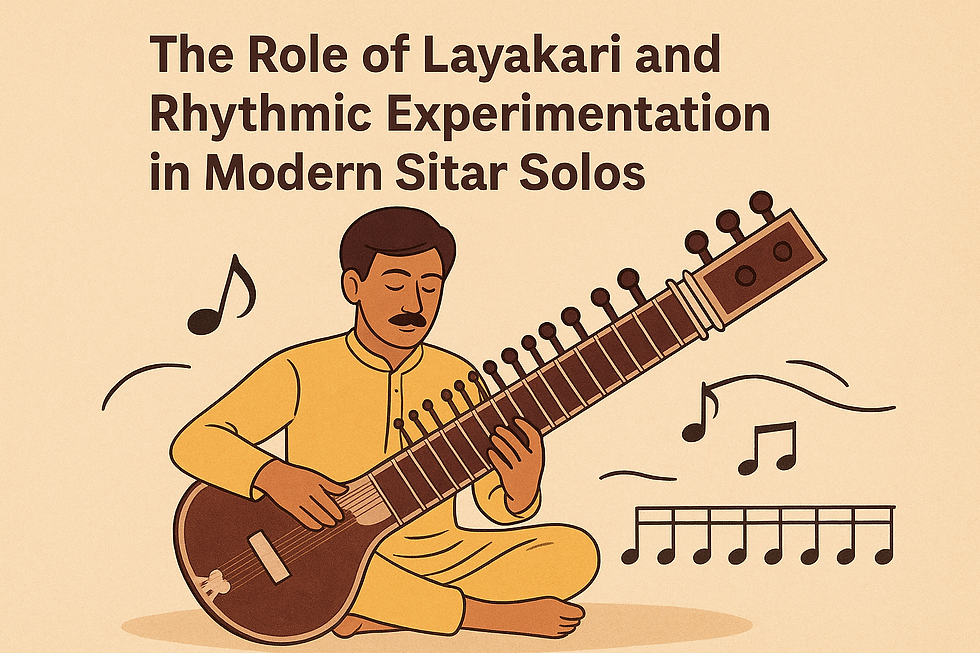"The Evolution of the Sitar: From Tansen to Today"
- Sharanya naidu
- Jun 25
- 3 min read
Updated: Jul 2
The sitar, an iconic instrument of Hindustani classical music, boasts a rich and complex history, evolving significantly over centuries to reach its present form. While its origins are sometimes debated, it's widely accepted that the sitar as we know it today developed primarily during the Mughal period, drawing influence from both Indian and Persian musical traditions.

The Myth of Tansen and the Early Sitar
It's a common misconception that the legendary musician Tansen, who graced Emperor Akbar's court in the 16th century, invented the sitar. While Tansen was a pivotal figure in Indian classical music, credited with creating new ragas and influencing the development of instruments like the rabab and surbahar, historical evidence does not support his invention of the sitar. The sitar, or at least its direct predecessor, likely emerged later.
Modern scholarship suggests that the sitar's invention is more accurately attributed to Khusrau Khan, an 18th-century figure of the Mughal Empire, who adapted the Persian setar (meaning "three strings"). There's also mention of a different Amir Khusru, a descendant of Tansen's son-in-law, Naubat Khan, who lived in the 18th century and is said to have developed the instrument from the Persian sehtar.
Key Evolutionary Milestones:
Early Forms (17th-18th Centuries): The initial sitar forms were simpler, possibly with three strings, reflecting its Persian setar influence. It gradually gained more strings and began to incorporate features from indigenous Indian instruments like the Veena, particularly its resonant bridge and the ability to bend strings laterally (meend), giving it a more vocal-like quality.
Masit Khan and the Dhrupad Influence (18th Century): Masit Khan, often cited as a grandson of the 18th-century Amir Khusru, played a significant role in the sitar's early development. He composed slow gats (compositions) in the dhrupad style, which became known as Masitkhani Gat, solidifying the sitar's place as a lead instrument rather than just an accompaniment.
Raza Khan and Faster Styles (19th Century): Ghulam Raza Khan, another descendant of Tansen's lineage, developed the faster Razakani gat in the 19th century, expanding the sitar's expressive potential and technical demands.
Structural Innovations (18th-19th Centuries): This period saw important physical modifications. The hollow body, initially made of glued wood lathes, transitioned to gourd, enhancing resonance. The introduction of the metallic plectrum (mizraab) was crucial for playing techniques. Crucially, the addition of chikari (rhythmic drone strings) and tarab (sympathetic resonating strings) greatly enriched the sitar's tonal complexity and characteristic shimmering sound.
20th Century and Global Recognition: The 20th century witnessed the sitar's meteoric rise to global prominence, largely due to the contributions of maestros like:
Pandit Ravi Shankar: He revolutionized sitar playing and brought Indian classical music to the Western world through his collaborations with artists like The Beatles (George Harrison famously became his student). His style emphasizes deep resonance and meditative ragas, influencing sitar design to this day (Ravi Shankar style sitar).
Ustad Vilayat Khan: Known for his lyrical and expressive gayaki ang (vocal style) of playing, he developed a distinct style and sitar design (Vilayat Khan style sitar) that emphasizes a crisper, brighter tone, often used for faster compositions.
Nikhil Banerjee: Celebrated for his introspective and meditative style, bringing a unique sensitivity to ragas.
Today's Sitar: Modern Innovations and Diverse Applications
The sitar continues to evolve in the 21st century, embracing new technologies and musical landscapes:
Electrification (Zitar): Innovations like the Zitar, an electrified sitar developed by Niladri Kumar, have increased its appeal to younger audiences and expanded its use in fusion genres.
Fusion Music: Modern sitarists are actively exploring fusion with Western genres like jazz, rock, and electronic music. Artists like Anoushka Shankar (Ravi Shankar's daughter) blend traditional Indian classical music with electronic and world music influences, while Rishabh Seen has even pioneered "Sitar Metal."
Contemporary Players: A new generation of sitarists is pushing the boundaries of the instrument while maintaining a deep respect for tradition. Notable contemporary players include:
Anoushka Shankar
Purbayan Chatterjee
Niladri Kumar (inventor of the Zitar)
Rishabh Seen (Sitar Metal)
Anupama Bhagwat (known for her Gayaki style)
Shahid Parvez (dynamic and spontaneous style)
Budhaditya Mukherjee (vibrant and emotive performances)
The sitar's journey from a relatively simple three-stringed instrument to its complex, resonant form today is a testament to the continuous innovation and artistic vision of generations of musicians. It remains a powerful symbol of Indian culture, adapting and thriving in an ever-changing global musical landscape.



Comments